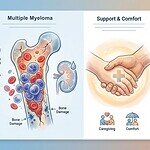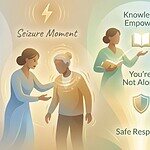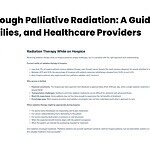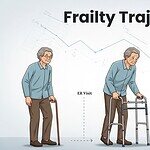Finding Your Way Through Traumatic Loss: A Compassionate Guide to Emotional Coping and Healing

When trauma and grief collide after suicide, homicide, or sudden accidents, the pain can feel unbearable. This guide offers practical coping strategies, self-care techniques, and professional resources to help you navigate traumatic loss. Learn the difference between grief support options and discover pathways toward healing.
Supporting Your Loved One with Multiple Myeloma: A Guide to Compassionate Care From Diagnosis Through End-of-Life

This comprehensive guide helps patients, families, and caregivers understand Multiple Myeloma diagnosis and staging, explore survival expectations, and navigate palliative and hospice care options. Discover practical caregiving strategies and when early palliative care can enhance quality of life.
When Dementia and Seizures Intersect: A Caregiver’s Guide to Recognition, Management, and Compassionate Care

When someone you love has dementia, seizures may become part of their journey. Learn which types of dementia increase seizure risk, how to recognize and respond to seizures safely, when to call for emergency help, and which medications may affect seizure risk. This compassionate guide empowers caregivers with knowledge and confidence.
Building Confidence in Home Hospice: A Proven Path to Better Patient Care

Hospice providers have proven strategies to reduce symptom burden and boost satisfaction scores. Discover how combining nurse practitioner telehealth visits, educational videos, and end-of-life doula support transforms caregiver confidence and patient comfort in home-based care.
Beyond Medical Care: How End-of-Life Doulas Transform the Journey for Patients and Families

End-of-life doulas offer untapped potential as compassionate partners in healthcare. These trained professionals complement hospice care by providing extended emotional and spiritual support, serving as life transition coaches long before hospice is needed—enhancing end-of-life experiences for families.
Understanding Acute Myeloid Leukemia: A Compassionate Guide to Disease Progression, Symptom Management, and End-of-Life Care

Navigate the journey of acute myeloid leukemia with confidence. This comprehensive guide covers disease progression, comfort-focused symptom management, and practical palliative and hospice care timing advice.
Why Planning for Long-Term Care Today Protects Your Family’s Tomorrow: The Critical Role of Elder Law Attorneys and Health and Life Navigation Specialists

A heartbreaking Facebook post reveals the devastating reality when families don't plan ahead for long-term care. Learn how Medicaid Asset Protection Trusts and working with life transition coaches years in advance can protect your home, savings, and dignity—and why the five-year lookback means you must act now.
Living Without Regret: What 300 Dying Patients Taught Us About What Truly Matters

After 15 years and 300 final breaths, nurse Laura M. discovered seven profound truths about what truly matters in life. Her patients didn't fear dying—they feared not having really lived. Learn these life-changing lessons and discover how life transition coaches can help you live with fewer regrets and ensure your wishes are honored.
The Transformative Role of Death Doulas: Bridging Gaps in End-of-Life Care

End-of-life doulas provide non-medical support that transforms dying experiences through education, emotional companionship, and advocacy. Learn how these trained professionals help patients and families navigate terminal illness with dignity, how healthcare providers can partner with doulas, and what to look for when selecting one.
Understanding Anticipatory Grief: How Loving Deeply Means Grieving Before Goodbye

Anticipatory grief is a normal, natural response to an expected loss that shows the depth of your love. This guide explains what anticipatory grief is, why it happens, how grief coaches and licensed counselors can help, and practical steps for families and caregivers to express feelings and find support during this difficult time.
Finding Peace in Loss: How End-of-Life Doulas and Health and Life Navigation Specialists Support Families Through Grief

Quality end-of-life care reduces complicated grief among families. Research shows that families who feel supported and witness dignified care experience fewer prolonged grief reactions. Learn how life transition coaches and end-of-life doulas provide essential emotional, spiritual, and practical support that bridges gaps in healthcare, helping families navigate loss with greater peace and understanding.
Finding Comfort Through Palliative Radiation: A Guide for Patients, Families, and Healthcare Providers

Palliative radiation therapy offers targeted symptom relief for patients with advanced cancer, reducing pain, bleeding, and other distressing symptoms. This comprehensive guide empowers patients and families to understand treatment options, manage side effects, and make informed decisions that prioritize comfort and quality of life.
The Hidden Crisis: Why Earlier Hospice Care Can Extend Life and Transform End-of-Life Experiences

Despite Medicare's six-month hospice benefit, most patients receive care for only 18-21 days, often when already transitioning to death. Research shows early hospice enrollment can extend life by 29-81 days while dramatically improving quality of life. Life transition coaches help families navigate earlier hospice and palliative care adoption for better outcomes.
Three Wishes: What a Dying Patient Taught Me About Living Without Regrets

A hospice nurse reflects on a powerful moment with a dying patient who painted "Three Wishes"—dandelions symbolizing childhood innocence and life's fleeting nature. This experience teaches us to examine how we're living, who we love, and what matters most. Learn why advance directives and living with fewer regrets matter for everyone.
Making Compassionate Care Accessible: A Guide to Sliding Scale Fees for End-of-Life Doulas

Looking to determine appropriate pricing for end-of-life doula services? This detailed guide compares sliding-scale fees with full-price and donation-based options. Learn effective strategies for establishing fair rates, applying a sliding-scale system, and ensuring compassionate care remains affordable for all families.
Understanding PACE: A Complete Guide to All-Inclusive Care That Keeps Seniors Home

The Program of All-Inclusive Care for the Elderly (PACE) provides essential support for seniors who require nursing home-level care but wish to remain in their communities. This comprehensive guide outlines eligibility requirements, available services, associated costs, and how PACE’s team-based approach helps older adults maintain their independence while receiving quality healthcare.
What Matters Most: The Three Things People Want Before They Die

A palliative care doctor shares people's three most common wishes at the end of life: mending relationships, expressing gratitude, and saying "I love you." Planning for a good death with the help of a life transition coach can help you accomplish more meaningful goals and ensure your final days reflect your values.
Hope Through Early Action: Understanding COPD and the Power of Early Detection

Chronic Obstructive Pulmonary Disease (COPD) is a serious lung condition linked to smoking and vaping that affects millions of people. Understanding the connection between tobacco use and COPD, recognizing early symptoms, and pursuing timely treatment can significantly extend life expectancy and improve quality of life.
Understanding Terminal Agitation and Restlessness: A Comprehensive Guide for Caregivers and Families

Navigating the complexities of end-of-life care can be challenging. This article delves into the nuances of terminal agitation and terminal restlessness, providing caregivers and family members with the essential knowledge to better understand and support their loved ones during the final stages of life.
Using the RAIN Method to Navigate Grief, Loss, and Anxiety with Compassion

The RAIN method is a powerful mindfulness technique that helps individuals process grief, loss, and anxiety. This four-step approach—recognize, allow, investigate, and nurture—provides a compassionate way to work through difficult emotions. Learn how caregivers, family members, and end-of-life professionals can use RAIN.
Hospice Care: Embracing Life’s Journey Through Comprehensive Support

Hospice care extends beyond end-of-life support, offering comprehensive services for patients with terminal illnesses. Early enrollment can provide months of valuable support, improving patient and family quality of life through specialized care and resources.
A New Path Forward: Using the Frailty Trajectory Model to Navigate Healthcare Decisions

The Frailty Trajectory Model offers a new way to understand how health changes over time, especially for older adults. This approach helps healthcare practitioners and life transition coaches guide patients through illness with compassion and clarity, making it easier to plan care that matches personal values and goals.
Guide to Becoming a Death Doula: Training Paths and Hidden Pitfalls

Becoming a death doula requires proper training, not just good intentions. While many suggest starting as a hospice volunteer, this path is fraught with problems - from limited training to ethical conflicts. Learn the right way to enter this meaningful field through legitimate certification programs and educational resources.
Understanding Medication Risks in Hospice Dementia Care: A Guide for Families and Healthcare Teams

Recent University of Michigan research found that benzodiazepines and antipsychotics commonly prescribed in hospice care may significantly increase mortality risk for people with dementia. This article explores these findings and provides essential advocacy guidance for families, caregivers, and hospice professionals.
